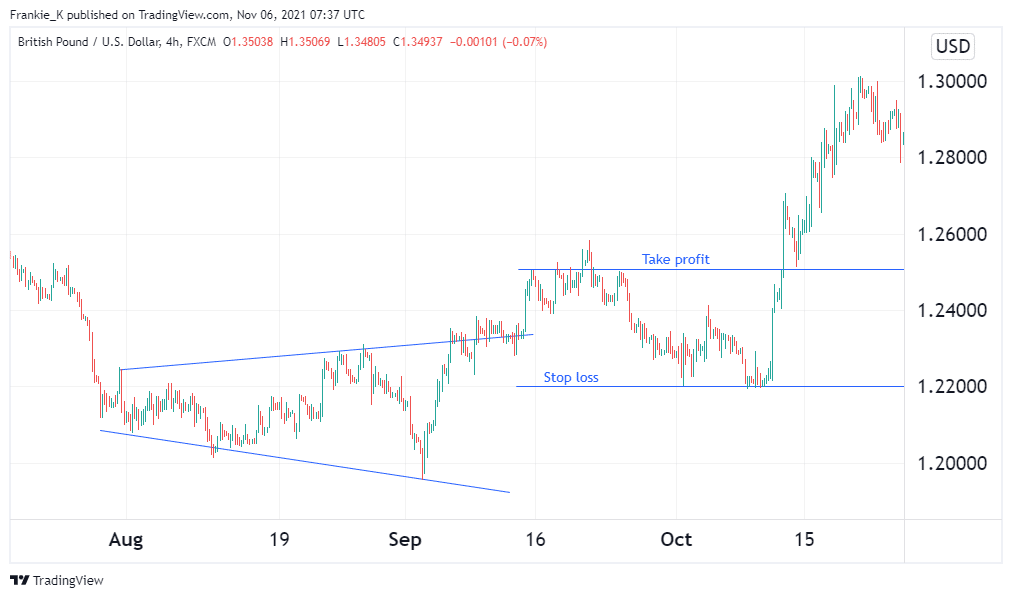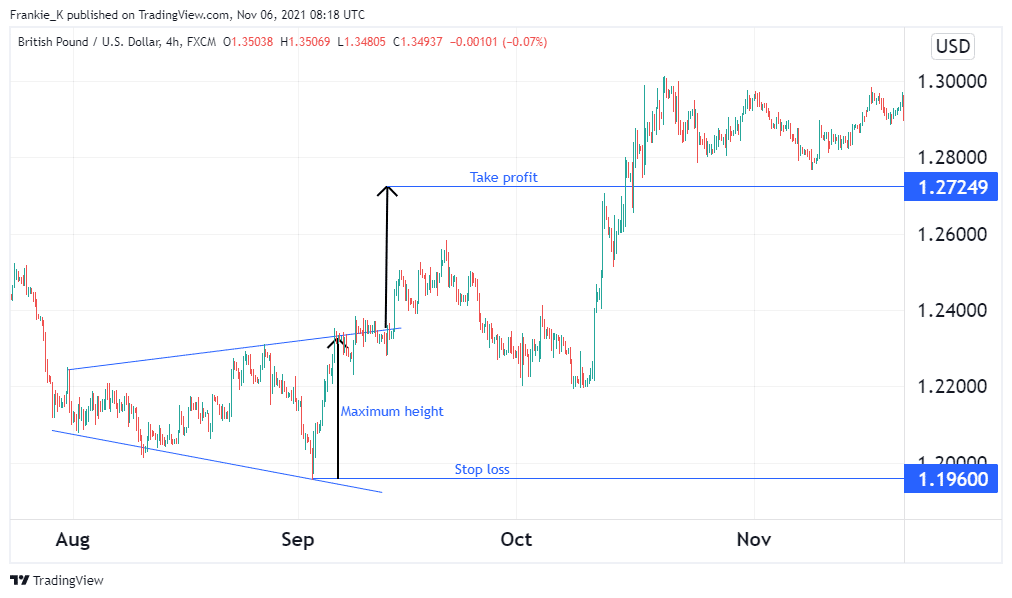The art of technical analysis involves using indicators and chart patterns. Chart patterns provide insight into the sentiment driving both sides of the forex market – buyers and sellers. By recognizing familiar patterns, expert traders can predict the most likely price outcome or direction of their breakouts. The broadening bottom pattern is one such pattern that results in a bullish reversal 58% of the time.
What is the broadening bottom pattern?
This is a pattern that occurs in bear markets. Usually, prices will tend to make lower lows and higher highs at the bottom of the bearish trend. When these swing highs and lows are connected via trendlines, the pattern looks like a broadening open-ended triangle. The shape formed resembles a megaphone as the subsequent swing lows and highs increase in height from support to resistance. Hence, some sources will refer to this pattern as a megaphone pattern.
How to identify a broadening bottom pattern
First and foremost, the pattern has to be preceded by a downtrend. In other words, the closing price at the start of the preceding trend has to be higher than the closing price at the beginning of the pattern. Additionally, the swing highs and lows formed during the pattern must form higher peaks and lower valleys as the pattern progresses.
The trendline joining the swing highs must be sloping upward, while those joining the swing lows must be sloping downward. Further, prices must touch the trendlines at least four times, and ideally, the second swing low or swing high should touch its corresponding trendline and not just come close. In addition, prices should fill the pattern area with side-to-side movements, as opposed to filling the area with whitespace.
This pattern may result in a breakout in either direction. However, upward breakouts are more common, as they happen around 60% of the time.
The psychology behind broadening bottoms
The setup shows that investors are increasingly growing nervous and indecisive. The swing highs are formed due to bulls who enter the market to make cheap purchases. However, sellers still dominate from the initial trend, which causes prices to go down hence the subsequent swing lows.
You should be careful with broadening bottoms as sometimes they may appear totally random. This may lead you to make inaccurate analyses.
How to trade the broadening bottom pattern
Strategy 1
The method involves taking a moderate risk to trade the breakout. To do this, you need to wait for the breakout to happen, whether in the upward or downward direction. If the breakout is upward, you’ll be looking to enter a long trade. If it is downward, that will prompt us to enter a short trade.
Regardless of which direction it happens, be careful to watch for a retest of the resistance or support level before the actual breakout happens. After the breakout, measure the height of the triangle at the beginning of the broadening bottom pattern. This distance, measured from the breakout point, will be the target for our profit. The stop loss should be placed a few pips below or above the breakout point, depending on the direction of the breakout.

In the chart above, we see a broadening bottom pattern in a 4-hour GBPUSD chart. The pattern has at least seven trendline touches, which confirms its validity. For this particular instance, the pattern resulted in an upward breakout. Prices consolidated around the upper trendline as they retested the resistance level, then rose upward to form the breakout.
The take profit was obtained by measuring the height of the pattern at its beginning and extending that distance upwards from the breakout point. The take profit was hit and became our first swing high after the breakout, which marked our exit. The stop loss was placed a few pips below the breakout point but not too close that a retest would have triggered it.
Strategy 2
This strategy is for the more aggressive risk-taker. It resembles the first strategy, except it aims for a bigger profit margin while using a much wider stop-loss. To utilize this strategy, measure the widest vertical height of the pattern, from the lower trendline to the top one. This distance, measured from the breakout point, will be our profit target. The stop-loss should be placed at the lower trendline or the pattern’s support level.
Below is an example of this strategy in practice.

In the above chart, the broadening bottom has an upward breakout. We measured the pattern’s maximum height, as shown by the black arrow on the left. The distance obtained was then measured upwards from the breakout point, which gave our profit target. The stop-loss was placed at the level of the lower trendline, which acted as support.
The strategy worked, with our profit being realized in the middle of October. The pair’s price even went to record higher highs later that month. Statistically, this strategy of the pattern’s maximum height works 60% of the time in the case of a bullish breakout. In the event of a bearish breakout, its chances of success rise to 70%.
Conclusion
The broadening bottom pattern is a chart pattern that occurs when the market is in a downturn. It manifests as prices making higher highs and lower lows. By connecting swing highs and swing lows, you obtain two symmetrical but divergent trendlines, which form a shape resembling a megaphone.
The swing highs are caused by bulls who try to make purchases at low prices. However, pressure from the bears is still strong, and from their indecision comes the lower swing lows characteristic of the pattern.
To trade this pattern, wait for the breakout first, as it could be in either direction. You may set your profit target at a distance equal to the least vertical height of the pattern or its maximum height.




